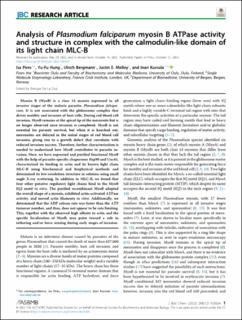Analysis of Plasmodium falciparum myosin B ATPase activity and structure in complex with the calmodulin-like domain of its light chain MLC-B
Journal article, Peer reviewed
Published version

View/
Date
2022Metadata
Show full item recordCollections
- Department of Biomedicine [710]
- Registrations from Cristin [9766]
Abstract
Myosin B (MyoB) is a class 14 myosin expressed in all invasive stages of the malaria parasite, Plasmodium falciparum. It is not associated with the glideosome complex that drives motility and invasion of host cells. During red blood cell invasion, MyoB remains at the apical tip of the merozoite but is no longer observed once invasion is completed. MyoB is not essential for parasite survival, but when it is knocked out, merozoites are delayed in the initial stages of red blood cell invasion, giving rise to a growth defect that correlates with reduced invasion success. Therefore, further characterization is needed to understand how MyoB contributes to parasite invasion. Here, we have expressed and purified functional MyoB with the help of parasite-specific chaperones Hsp90 and Unc45, characterized its binding to actin and its known light chain MLC-B using biochemical and biophysical methods and determined its low-resolution structure in solution using small angle X-ray scattering. In addition to MLC-B, we found that four other putative regulatory light chains bind to the MyoB IQ2 motif in vitro. The purified recombinant MyoB adopted the overall shape of a myosin, exhibited actin-activated ATPase activity, and moved actin filaments in vitro. Additionally, we determined that the ADP release rate was faster than the ATP turnover number, and thus, does not appear to be rate limiting. This, together with the observed high affinity to actin and the specific localization of MyoB, may point toward a role in tethering and/or force sensing during early stages of invasion.
